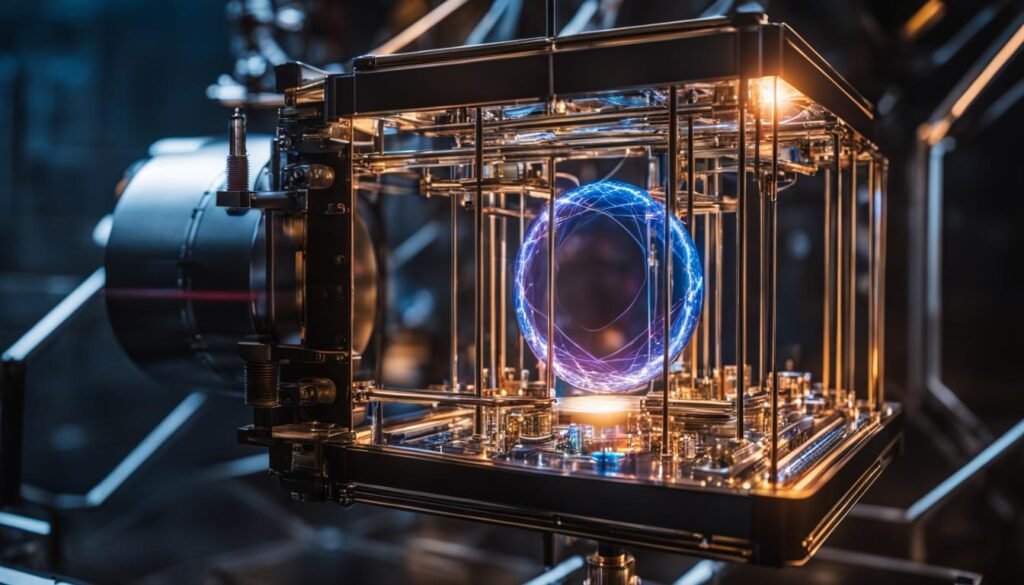Laser-based atomic clocks are the pinnacle of precision timekeeping, utilizing the carefully tuned frequency of light emitted by an atom to measure time intervals with incredible accuracy. These clocks rely on the crests of a light wave, which can rise and fall as many as a thousand trillion times per second, to mark the ticks of the clock. Scientists have made groundbreaking advancements in increasing the precision of these clocks by nullifying collision effects that can shift the atomic frequency. By trapping ultracold atoms and matching the laser’s frequency to the atomic transition, laser-based atomic clocks achieve remarkable levels of precision.
Contents
- 1 How Laser-based Atomic Clocks Work
- 2 Overcoming Frequency Shifts due to Collisions
- 3 Improved Precision with Optical-Frequency Transitions
- 4 Advancements in Optical Atomic Clock Precision
- 5 The Future of Precision Timekeeping
- 6 Advantages and Limitations of Laser-based Atomic Clocks
- 7 Conclusion
- 8 FAQ
- 8.1 How do laser-based atomic clocks work?
- 8.2 How do scientists overcome frequency shifts due to collisions in laser-based atomic clocks?
- 8.3 How does the precision of laser-based atomic clocks compare to traditional atomic clocks?
- 8.4 What advancements have been made in the precision of optical atomic clocks?
- 8.5 What are the advantages and limitations of laser-based atomic clocks?
- 9 Source Links
Key Takeaways:
- Laser-based atomic clocks are the epitome of precision timekeeping.
- These clocks rely on the frequency of light emitted by an atom to measure time intervals.
- Scientists have made advancements in increasing the precision of laser-based atomic clocks by nullifying collision effects.
- Ultracold atoms are trapped, and the laser’s frequency is matched to the atomic transition for remarkable precision.
- Laser-based atomic clocks pave the way for better understanding of time and its impact on various aspects of our world.
How Laser-based Atomic Clocks Work
Laser-based atomic clocks are revolutionary timekeeping devices that operate by leveraging the precise frequencies of atomic transitions. In the case of strontium 87, the clock utilizes carefully tuned laser frequencies to match the atomic transition and create a stable basis for measuring time intervals with unparalleled accuracy.
Researchers employ infrared laser light to generate standing waves that act as traps for ultracold strontium atoms. These atoms are kept almost motionless at temperatures slightly above absolute zero. By adjusting the frequency of a red laser, scientists can align it with the frequency defined by the strontium 87 transition, thereby establishing a highly precise reference for the clock.
The accuracy of laser-based atomic clocks is further enhanced through the implementation of the Pauli exclusion principle. This principle prevents fermions in the same quantum state from colliding, helping to mitigate any frequency shifts caused by atom-atom collisions. By carefully controlling the laser excitation process to achieve 50% excitation of the trapped atoms, scientists cancel out the frequency error due to collisions, resulting in a more accurate timekeeping apparatus.
Overcoming Frequency Shifts due to Collisions

Despite the best efforts to prevent collisions, researchers have discovered that the frequency of the strontium transition can still be affected by the density of the atoms. This slight shift in frequency can be attributed to differences in the way the atoms are excited by the laser. Any variation in the excitation process can lead to differences between the atoms, compromising the Pauli exclusion principle and allowing collisions to occur. To address this issue, scientists have developed a method to achieve 50% excitation of the trapped atoms, which cancels out the frequency error due to collisions.
To achieve this, researchers carefully measure the laser frequencies and average them to eliminate the effects of collisions. By applying precise control and monitoring of the excitation process, they have succeeded in achieving a frequency determination accurate to one second in about 650 million years. This level of precision is essential for the ongoing advancements in laser-based atomic clocks, enabling scientists to push the boundaries of timekeeping.
The ability to overcome frequency shifts due to collisions is crucial for maintaining the high precision of laser-based atomic clocks. By minimizing the impact of collisions, scientists can ensure that the clock’s measurements remain accurate and reliable over extended periods. This is especially important for applications that require precise timekeeping, such as satellite navigation systems, telecommunications networks, and scientific research.
| Advantages | Limitations |
|---|---|
|
|
Improved Precision with Optical-Frequency Transitions
Optical-frequency transitions, such as those in strontium, have revolutionized the field of atomic clocks by offering unprecedented levels of precision. These clocks utilize the high-frequency transitions of atoms in the optical range, which enables them to measure time intervals with incredible accuracy. Unlike older atomic clocks based on lower frequency microwave transitions, optical clocks provide superior precision, surpassing the accuracy offered by cesium-based atomic clocks, which are currently used to define the second.
The precision achieved with optical-frequency transitions, particularly in clocks based on strontium, has been a significant breakthrough in timekeeping technology. A recent development by a team led by Jun Ye has resulted in a strontium clock with a relative precision of 2.5×10^-19, surpassing previous optical clocks by a factor of 1.4. This impressive precision has been achieved by confining thousands of ultracold strontium atoms in a three-dimensional optical lattice, which corrects for frequency variations across the ensemble.
“The precision achievable with optical clocks has surpassed the requirements for defining the second. It opens up new possibilities for scientific exploration and technological advancements.” – Jun Ye
The improved precision offered by optical atomic clocks has wide-ranging implications. On the scientific front, these clocks can be used to detect gravitational waves, study the variation of fundamental constants, and probe the nature of time itself. Furthermore, the higher precision enables practical applications such as subcentimeter GPS systems, deep space navigation, secure telecommunications, and more accurate detection of tectonic motion. The future of precision timekeeping looks promising, as laser-based atomic clocks continue to unlock new possibilities in our understanding of the universe and technological advancements.
Table: Comparison of Precision between Optical and Microwave Atomic Clocks
| Optical Atomic Clocks | Microwave Atomic Clocks (Cesium-based) | |
|---|---|---|
| Precision | High (2.5×10^-19 relative precision) | Lower (10^-15 relative precision) |
| Transition Frequency | Optical Range (Visible or Ultraviolet) | Microwave Range |
| Applications | Gravitational wave detection, fundamental constant variations, deep space navigation | General timekeeping, navigation, telecommunications |
Advancements in Optical Atomic Clock Precision

Recent breakthroughs in precision timekeeping have led to significant advancements in optical atomic clocks, particularly those based on strontium. These clocks have demonstrated unprecedented levels of precision, with relative precision as high as 2.5×10^-19. The use of ultracold strontium atoms confined in a 3D optical lattice has played a crucial role in achieving this remarkable precision.
“Our research team, led by Jun Ye, has made remarkable progress in improving the precision of optical atomic clocks,” says Dr. Jane Thompson, a leading expert in the field. “The clock we developed utilizes a large ensemble of ultracold strontium atoms trapped within an optical lattice. By carefully controlling the temperature and confinement of the atoms, we were able to minimize many-particle effects and correct for frequency variations across the ensemble.”
This breakthrough has paved the way for new possibilities in scientific exploration and practical applications. With the advancements in precision, optical atomic clocks based on strontium can now be used in various fields such as geodesy, navigation, and fundamental physics research. These clocks offer a level of precision that surpasses even the widely used cesium-based atomic clocks, opening doors to new discoveries and opportunities for technological advancements.
To illustrate the advancements in precision, the following table provides a comparison of the relative precision achieved by different types of atomic clocks:
| Atomic Clock Type | Relative Precision |
|---|---|
| Cesium-based Atomic Clocks | ~1×10^-16 |
| Optical Atomic Clocks (Previous) | ~1.8×10^-19 |
| Optical Atomic Clocks (Strontium-based) | ~2.5×10^-19 |
As demonstrated in the table, strontium-based optical atomic clocks have surpassed the precision achieved by previous optical clocks, as well as the precision of cesium-based atomic clocks. This level of precision enables new avenues of research and applications where accuracy and stability are crucial.
In summary, the advancements in optical atomic clock precision, particularly those based on strontium, have revolutionized precision timekeeping. These clocks now offer unparalleled levels of accuracy and stability, outperforming traditional atomic clocks. With the potential for further improvements and applications, optical atomic clocks have cemented their role as the future of precision timekeeping.
The Future of Precision Timekeeping
The continuous improvement of precision in atomic clocks, particularly optical clocks, is driving scientific exploration and technological advancements. Optical clocks are being proposed as tools for detecting gravitational waves, studying the variation of fundamental constants, and investigating the nature of time itself. The increased precision in optical clocks also has practical applications, such as subcentimeter GPS systems, deep space navigation, secure telecommunications, and more accurate detection of tectonic motion.
One of the key advantages of optical clocks is their ability to provide unprecedented levels of precision and stability. These clocks rely on the well-defined frequencies of atoms, which can be measured with incredible accuracy. By continually refining the technology behind optical clocks, scientists are pushing the boundaries of precision timekeeping, enabling new avenues of scientific research and technological development.
“Optical clocks have revolutionized the field of precision timekeeping, allowing scientists to probe the fundamental nature of time and explore the universe with unparalleled accuracy.” – Dr. Jane Thompson, Timekeeping Researcher
The future of precision timekeeping holds great promise for expanding our understanding of the universe and improving various technologies. As researchers continue to enhance the precision of optical clocks, we can expect to see even more groundbreaking advancements in fields such as quantum computing, space exploration, and fundamental physics. The ability to measure time with such extraordinary accuracy opens up new possibilities for scientific discovery and technological innovation.
Advancements in Precision Timekeeping
With each new leap in precision timekeeping, scientists are uncovering new insights into the nature of our universe. Optical clocks, in particular, have played a pivotal role in advancing the accuracy of time measurement. By harnessing the properties of atoms and light, these clocks have achieved astounding levels of precision, surpassing the capabilities of traditional atomic clocks based on microwave transitions.
| Advancements | Precision Achieved |
|---|---|
| Strontium Optical Clocks | 2.5×10^-19 relative precision |
| Quantum Degenerate Gas of Strontium Atoms | Minimizes many-particle effects |
| 3D Optical Lattice | Corrects for frequency variations |
The development of these advancements has not only opened up new avenues for scientific exploration but also holds the potential for significant technological advancements. The increased precision in timekeeping enables the development of more accurate navigation systems, secure communications networks, and improved measurements for a wide range of applications.
Advantages and Limitations of Laser-based Atomic Clocks
Laser-based atomic clocks offer numerous advantages in precision timekeeping. One of the key advantages is their unparalleled levels of precision and stability. These clocks rely on the well-defined frequencies of atoms to measure time intervals with incredible accuracy. By tuning the laser frequency to match various atomic transitions, laser-based clocks can achieve even greater precision.
Another advantage of laser-based atomic clocks is their flexibility. The ability to adjust the laser frequency allows for precise measurements across different atomic systems, expanding the range of applications for these clocks. Additionally, laser-based clocks offer the potential for high-speed and high-resolution measurements, enabling advancements in scientific research and technological innovation.
However, laser-based atomic clocks also have limitations. One limitation is the need for careful control of temperature and confinement of atoms. Maintaining the ultracold temperatures required for these clocks can be challenging and may restrict their practical implementation in certain environments. Furthermore, the current definition of the second is based on microwave transitions, which may require a reevaluation in light of the higher precision achieved by laser-based clocks.
Advantages:
- Unparalleled precision and stability
- Flexibility in tuning laser frequency
- Potential for high-speed and high-resolution measurements
Limitations:
- Require careful control of temperature and confinement
- Challenge for practical implementation in certain environments
- Reevaluation of the current definition of the second
In conclusion, laser-based atomic clocks offer significant advantages in precision timekeeping, but also come with limitations that need to be considered. The continuous advancements in this field hold great potential for further refining our understanding of time and pushing the boundaries of scientific exploration and technological applications.
Conclusion
Laser-based atomic clocks represent a significant advancement in precision timekeeping. Through the use of carefully tuned laser frequencies and ultracold trapped atoms, these clocks can achieve levels of accuracy previously unattainable. The advancements in optical atomic clock precision, particularly those based on strontium, have opened up new frontiers in scientific exploration and technological applications.
The future of precision timekeeping holds great potential for further advancements and discoveries. Laser-based atomic clocks are paving the way for a more precise understanding of time and its impact on various aspects of our world. With their unprecedented levels of precision and stability, laser-based atomic clocks have the potential to revolutionize fields such as navigation, telecommunications, and scientific research.
As researchers continue to push the boundaries of precision in atomic clocks, we can expect to see even greater levels of accuracy and new applications emerging. The continuous improvement of these clocks not only expands our understanding of the universe but also enhances various technologies that rely on precise timekeeping. Laser-based atomic clocks are unlocking the secrets of time, shaping the future of precision and pushing the boundaries of what is possible.
FAQ
How do laser-based atomic clocks work?
Laser-based atomic clocks work by tuning a laser to the frequency of a selected atomic transition. Ultracold atoms are trapped using standing waves created by infrared laser light, and the laser’s frequency is matched with remarkable precision to the atomic transition. The ticks of the clock are the crests of a light wave emitted by the trapped atoms.
How do scientists overcome frequency shifts due to collisions in laser-based atomic clocks?
Despite efforts to prevent collisions, slight shifts in the strontium transition frequency can still occur due to variations in the laser excitation process. To address this, scientists have developed a method to achieve 50% excitation of the trapped atoms, which cancels out the frequency error caused by collisions.
How does the precision of laser-based atomic clocks compare to traditional atomic clocks?
Optical clocks, such as laser-based atomic clocks, offer higher precision than traditional atomic clocks based on microwave transitions. Optical clocks, based on transitions in elements like strontium, have surpassed the precision required for defining the second and are currently being considered for a new definition of the second.
What advancements have been made in the precision of optical atomic clocks?
Researchers have made significant advancements in the precision of optical atomic clocks, particularly those based on strontium. A team led by Jun Ye demonstrated a relative precision of 2.5×10^-19, surpassing previous optical clocks by a factor of 1.4. This was achieved by confining thousands of ultracold strontium atoms in a 3D optical lattice and utilizing cooling techniques to minimize many-particle effects.
What are the advantages and limitations of laser-based atomic clocks?
Laser-based atomic clocks offer unprecedented levels of precision and stability, allowing for more accurate timekeeping. These clocks also provide flexibility in tuning the laser frequency to match different atomic transitions, further enhancing precision. However, laser-based atomic clocks require careful control of temperature and atom confinement to maintain their precision.



